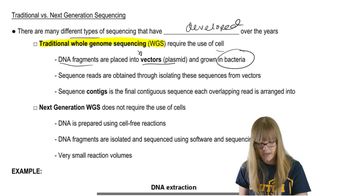Table of contents
- 1. Introduction to Genetics51m
- 2. Mendel's Laws of Inheritance3h 37m
- 3. Extensions to Mendelian Inheritance2h 41m
- 4. Genetic Mapping and Linkage2h 28m
- 5. Genetics of Bacteria and Viruses1h 21m
- 6. Chromosomal Variation1h 48m
- 7. DNA and Chromosome Structure56m
- 8. DNA Replication1h 10m
- 9. Mitosis and Meiosis1h 34m
- 10. Transcription1h 0m
- 11. Translation58m
- 12. Gene Regulation in Prokaryotes1h 19m
- 13. Gene Regulation in Eukaryotes44m
- 14. Genetic Control of Development44m
- 15. Genomes and Genomics1h 50m
- 16. Transposable Elements47m
- 17. Mutation, Repair, and Recombination1h 6m
- 18. Molecular Genetic Tools19m
- 19. Cancer Genetics29m
- 20. Quantitative Genetics1h 26m
- 21. Population Genetics50m
- 22. Evolutionary Genetics29m
7. DNA and Chromosome Structure
Eukaryotic Chromosome Structure
Problem 20
Textbook Question
Textbook QuestionIn a study of Drosophila, two normally active genes, w⁺ (wild-type allele of the white-eye gene) and hsp26 (a heat-shock gene), were introduced (using a plasmid vector) into euchromatic and heterochromatic chromosomal regions, and the relative activity of each gene was assessed [Sun et al. (2002)]. An approximation of the resulting data is shown in the following table. Which characteristic or characteristics of heterochromatin are supported by the experimental data? Gene Activity (relative percentage) _ Euchromatin Heterochromatin hsp26 100% 31% w⁺ 100% 8%
 Verified Solution
Verified SolutionThis video solution was recommended by our tutors as helpful for the problem above
Video duration:
2mPlay a video:
Was this helpful?
Key Concepts
Here are the essential concepts you must grasp in order to answer the question correctly.
Euchromatin vs. Heterochromatin
Euchromatin and heterochromatin are two forms of chromatin found in eukaryotic cells. Euchromatin is less condensed, transcriptionally active, and accessible for gene expression, while heterochromatin is more tightly packed, transcriptionally inactive, and often associated with gene silencing. Understanding these differences is crucial for interpreting gene activity data in the context of chromosomal regions.
Recommended video:
Guided course

Traditional vs. Next-Gen
Gene Expression Regulation
Gene expression regulation refers to the mechanisms that control the transcription and translation of genes, influencing how much of a gene product is produced. Factors such as chromatin structure, transcription factors, and epigenetic modifications play significant roles in determining whether genes are active or silenced. The experimental data highlights how the chromatin environment affects the expression levels of the introduced genes.
Recommended video:
Guided course

Penetrance and Expressivity
Heat-Shock Response
The heat-shock response is a cellular mechanism activated by stress conditions, such as elevated temperatures, leading to the expression of heat-shock proteins like hsp26. These proteins help protect and refold damaged proteins, ensuring cell survival. The reduced activity of hsp26 in heterochromatin suggests that the chromatin state can influence the cell's ability to respond to stress, which is a key characteristic of heterochromatin.
Recommended video:
Guided course

History and Experiments

 7:10m
7:10mWatch next
Master Chromosome Structure with a bite sized video explanation from Kylia Goodner
Start learningRelated Videos
Related Practice



